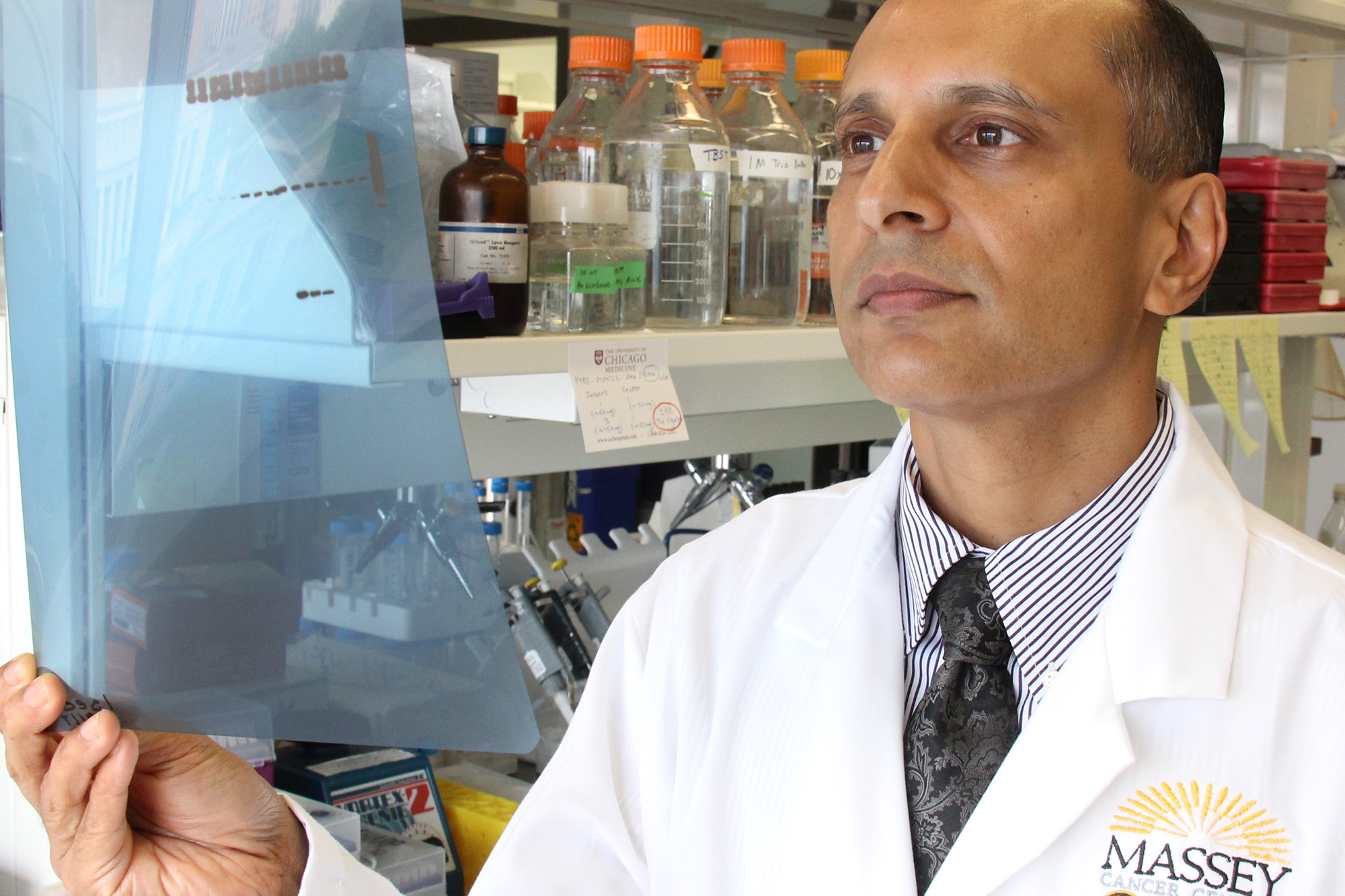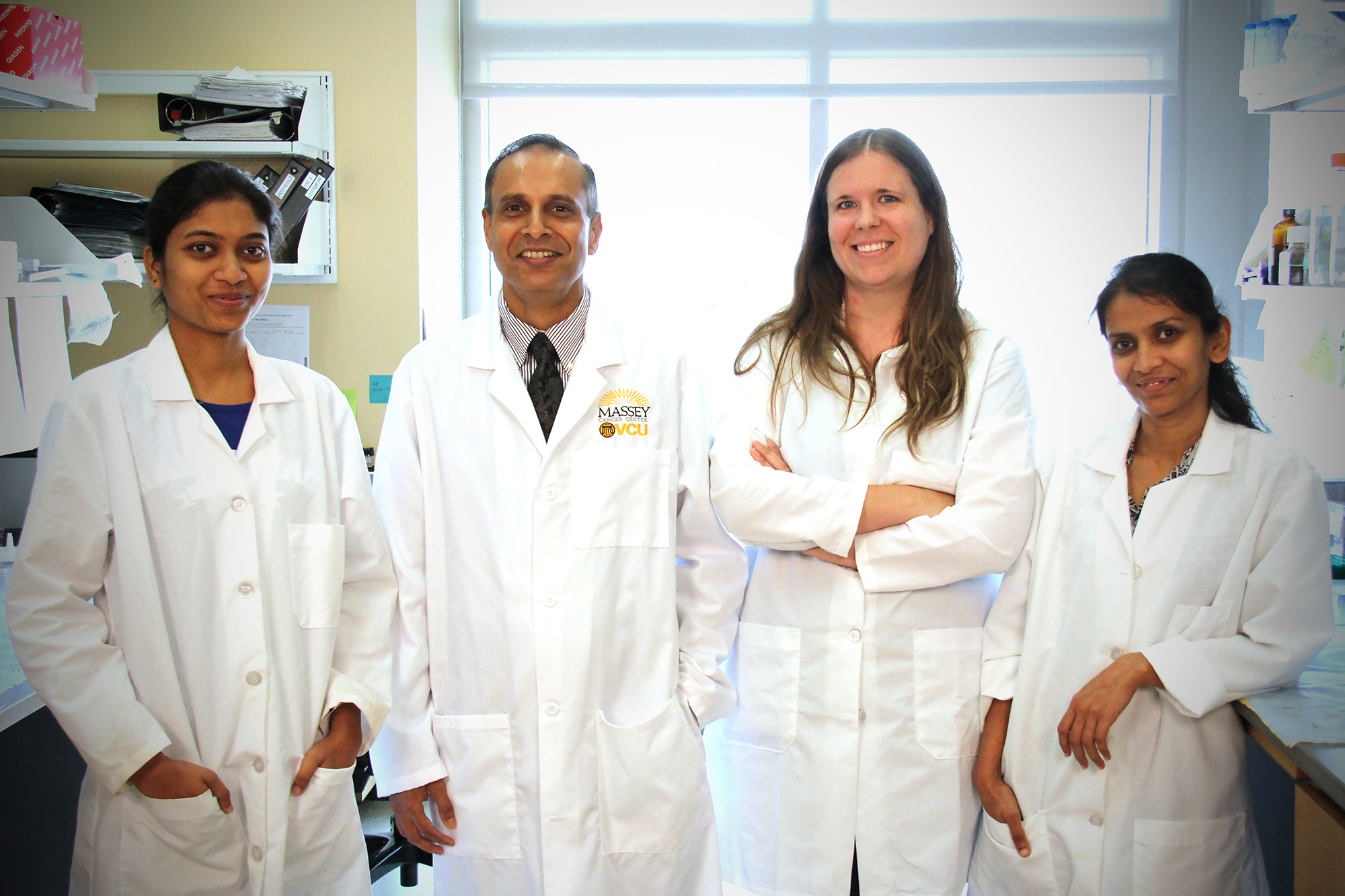Latest News
Research & Innovation
Commitment to a cure for liver cancer
Aug 22, 2017

When Devanand Sarkar, M.B.B.S., Ph.D., came to VCU Massey Cancer Center in 2008, he wanted to pursue a new direction in his research. Driven by the loss of his close friend and colleague, Sarkar has been on a mission to better understand the processes that drive the development of liver cancer. Now, nearly a decade after he started, his research is close to bringing about new treatments for the disease while redefining how obesity is connected to cancer.
In America, one of the biggest drivers of liver cancer is fatty liver disease due to obesity. Obesity leads to the deposition of fat in the liver, which causes chronic inflammation and eventually develops into cancer. The mechanisms behind this transformation were a mystery waiting for Sarkar to unravel.
“It started with this gene, AEG-1,” remembers Sarkar, who is the associate director for education and training at Massey, holds the Harrison Foundation Distinguished Professorship in Cancer Research and is a member of Massey’s Cancer Molecular Genetics research program.
Sarkar and his colleagues had originally discovered and cloned AEG-1 at Columbia University in the laboratory of Paul Fisher, M.Ph., Ph.D., who is now professor and chair of the Department of Human and Molecular Genetics at VCU School of Medicine, director of the VCU Institute of Molecular Medicine and member of the Cancer Molecular Genetics research program at Massey.
In a study published in the Journal of Clinical Investigation in 2009, Sarkar demonstrated that AEG-1 was overexpressed in hepatocellular carcinoma (HCC), the most common form of liver cancer, and outlined some of the molecular mechanisms associated with the gene. This was also the year that Sarkar’s friend and colleague, Zao-zhong Su, Ph.D., was diagnosed with liver cancer.
“I worked closely with Dr. Su for 7 years in New York before we both came to VCU,” said Sarkar, who is also an associate professor in the Department of Human and Molecular Genetics at the VCU School of Medicine and the associate scientific director, Cancer Therapeutics, at the VCU Institute of Molecular Medicine. “He passed away 2 years after he was diagnosed. I might have moved on to other things, but his loss was a very personal experience and it kept me focused on the disease.”
By the time Dr. Su passed away, Sarkar was beginning to show some of the ways in which AEG-1 interacted with other molecules to drive the development of liver cancer.
In a 2011 study published in the journal of Hepatology, Sarkar’s team discovered that AEG-1 worked with another gene called SND1 to increase the function of RNA-induced silencing complex (RISC), thereby promoting HCC. This pre-clinical study clearly identified SND1 as a novel regulator of liver cancer and a promising target for future therapies. But Sarkar needed to move beyond in vitro studies in the lab to better understand all of the ways in which AEG-1 and SND1 caused liver cancer.
In vivo
In vivo – Latin for “within the living” – refers to studies examining the effects of biological processes in living organisms, as opposed to in vitro – “in the glass”, which means that the studies are done in a controlled environment outside of a living organism. In a 2012 study published in Hepatology, Sarkar developed the first mouse model demonstrating how AEG-1 accelerated the progression of liver cancer. The study was also one of the first showing a mechanistic link between cancer and obesity.
Sarkar found that mice producing an excess of the AEG-1 protein developed highly aggressive liver cancer. In addition, he and his research team found that AEG-1 protected cancer cells from chemotherapy and promoted the growth of blood vessels in tumors.
“The ability to develop conditional mouse models was a game changer,” said Sarkar, who took advantage of Massey’s Transgenic/Knock-out Mouse Shared Resource Core, which provides mouse models with specific genetic characteristics to facilitate translational research. “The mouse models allowed us to perform a variety of experiments showing how AEG-1 interacts with other molecules in its environment to influence not only the development of liver cancer but also metabolic processes.”
 Lab members Saranya Chidambaranathan-Reghupaty, Devanand Sarkar, Rachel G. Mendoza and Nidhi Jariwala
Lab members Saranya Chidambaranathan-Reghupaty, Devanand Sarkar, Rachel G. Mendoza and Nidhi Jariwala
In the following years, Sarkar and his colleagues published a flurry of studies in prominent cancer journals detailing their experiments involving transgenic mice, which overexpress certain genetic characteristics such as the AEG-1 gene, and knockout mice, which have certain genetic characteristics eliminated. By controlling genetic variables, the researchers were able to learn more about the biology of liver cancer and also test the effects of new therapies.
In 2014 and 2015, Sarkar and his team published several more studies detailing novel interactions involving AEG-1. One study, published in the journal Cancer Research, showed that mice no longer expressing the AEG-1 gene were resistant to liver cancer and protected against aging-associated inflammation and tumor development. Another, published in Hepatology in March of 2015, showed AEG-1 could influence cellular division and metabolism by interacting with the gene c-Myc. Mice overexpressing both of these genes developed spontaneous liver cancer with lung metastases due to the activation of multiple pro-cancer cell signaling pathways. A third study, published in the Journal of Biological Chemistry (JBC), showed that AEG-1 blocks thyroid hormone function and contributes to nonthyroidal illness syndrome, a condition common in patients with liver cancer. An additional study, also published in JBC, provided a definitive link between AEG-1 and obesity. It detailed experiments in which mice no longer expressing AEG-1 remained lean and lived longer even when fed high-fat diets. The absence of AEG-1 increased the activity of several factors in the intestines that prevented the absorption of fat.
Therapeutic development
In tandem with these studies, Sarkar’s team was also working on a new treatment approach targeting AEG-1. In a study published in Cancer Research in 2014, Sarkar identified a novel mechanism by which AEG-1 blocks the cancer inhibitory function of retinoic acid (vitamin A) and established the proof-of-principle that a combination of retinoic acid and AEG-1 inhibition synergistically inhibits growth of liver cancer cells. This study resulted in a follow-up paper published in 2015 describing a nanoparticle-based therapy that delivered a combination of retinoic acid and AEG-1 inhibitors directly to the liver.
“The success of these experiments made us hopeful that this experimental therapy could someday become an effective treatment for human patients,” said Sarkar.
The liver often blocks drugs from reaching other organs in the body, which is an advantage when developing therapies for liver cancer. Sarkar partnered with Aliasger Salem, Ph.D., head of the Division of Pharmaceutics and Translational Therapeutics at the University of Iowa, whose labs are equipped to produce clinical-grade nanoparticles. They developed a lipid-based nanoparticle designed to target specific receptors found on the surface of liver cells. When the nanoparticles reach the liver, they deliver siRNA – small molecules that can block the expression of genes such as AEG-1.
While Sarkar remained focused on the therapeutic promise of AEG-1, he continued his research on SND1 and other genetic targets that interact with AEG-1 and contribute to liver cancer.
One such study was published in Cancer Research in June of this year, and it showed that AEG-1 inhibited the expression of a gene known as IGFBP7. IGFBP7 normally functions as a tumor suppressor, and it becomes silenced in liver cancers expressing excess AEG-1. Mice no longer expressing the IGFBP7 gene developed aggressive liver cancer, and Sarkar and his colleague Xiang-Yang Wang, Ph.D., Harrison Endowed Scholar in Cancer Research at Massey and a member of Massey’s Cancer Molecular Genetics research program, found that anti-tumor immune responses were significantly weakened in these mice. Inhibition of IGFBP7 was found to be another way in which AEG-1 drives the development of liver cancer.
In another study published in Cancer Research around the same time, Sarkar’s team identified a surprising drug that could be used to target SND1 for the treatment of liver cancer.
The researchers found an increase in tumor-initiating cells in mouse models with liver-specific overexpression of SND1. These mice developed spontaneous and aggressive liver cancer, which was the first confirmation that SND1 could function alone as an oncogene, which is a gene that directly contributes to the development of cancer. However, a drug known as pdTp, a specific inhibitor for SND1 that was discovered and practically forgotten more than 50 years ago, was found to prevent the development of tumor-initiating cells in liver cancer and also prevented the growth of liver cancer cells implanted in immune-compromised mouse models.
“SND1 is the only gene in the human genome that contains the staphylococcus nuclease domain,” said Sarkar, explaining how humans inherited what was once a bacterial protein designed to protect against invading viruses. In humans and other higher organisms, five of these staphylococcus nuclease domains came together to form the SND1 gene. “The drug pdTp was originally developed long ago by bacteriologists to block the bacterial staphylococcus nuclease, but it never made it out of the lab. We are the first to show that this agent can kill liver cancer cells both in vitro and in vivo.”
Even though pdTp has been around for quite some time, it has never been tested as a therapeutic agent, so Sarkar’s team must perform many additional experiments to show that it is safe and has the potential to effectively treat liver cancer.
His nanoparticle therapy targeting AEG-1 is much further along, and in April 2017 he published another study in the journal Hepatology detailing his latest findings. In that study, Sarkar’s team found that overexpression of AEG-1 caused mice to spontaneously develop nonalcoholic steatohepatitis (NASH), which is a fatty liver disease caused by factors other than alcohol. NASH is a primary risk factor for liver cancer and is directly linked to obesity. The researchers found that mice without the AEG-1 gene were protected from NASH even when consuming a high-fat diet. Using their nanoparticle therapy, they were able to block AEG-1 expression and protect normal mice from developing NASH.
“The same type of nanoparticle that we are developing is currently being tested in clinical trials for another disease, so we are confident we will eventually be approved for clinical trials,” says Sarkar. “We have partnered with the National Cancer Institute’s Nanotechnology Characterization Laboratory (NCL), which can provide an independent validation of our therapy and should make getting clinical trial approval much easier.”
Even with NCL’s validation, there are hurdles Sarkar and his colleagues must overcome.
“Funding is always an issue. Positive results from the NCL will help us apply for additional grants, but production of the therapy and administration of clinical trials can be very costly,” says Sarkar. “Even though I can’t give an exact estimate on when, I’m confident we will bring this treatment to the clinic.”
While he works with his colleagues at VCU and the University of Iowa to bring about his nanoparticle-based therapy targeting AEG-1, Sarkar plans to continue experiments focused on SND1 and other genes that play a role in promoting liver cancer. Ultimately, it may be a combination of therapies that offer patients the best chance of beating the disease that claimed his friend’s life. Sarkar remains hopeful that his work will make an impact toward that end.
Written by: John Wallace
Related News
Research & Innovation
Robert A. Winn Excellence in Clinical Trials Program Annual Convening highlights long-term, dynamic public-private partnershipNov 24, 2025
Research & Innovation
Commonwealth of Virginia Cancer Research Conference unites cancer researchers, students, and trainees from across the stateNov 21, 2025
Research & Innovation
Targeted drug could benefit pediatric and young adult patients with invasive soft tissue cancerNov 18, 2025

Get access to new, innovative care
Treatments in clinical trials may be more effective or have fewer side effects than the treatments that are currently available. With more than 200 studies for multiple types of cancers and cancer prevention, Massey supports a wide array of clinical trials.

Find a provider
Massey supports hundreds of top cancer specialists serving the needs of our patients. Massey’s medical team provides a wealth of expertise in cancer diagnosis, treatment, prevention and symptom management.
